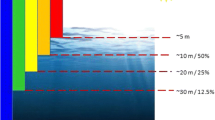Abstract
In this paper, a method has been proposed for enhancement of underwater images commonly suffering from low contrast and degraded shading quality. The entirety of the image is changed when we move to capture of images, from air to the water. During capturing some absorption, reflection and scattering effects are induced in the form of contrast, quality and noise as the images look hazy or blurred. This makes one shading to overwhelm the image. For use of underwater resources and overcome these factors the enhancement of the images is required. So, in this paper, we proposed a strategy for underwater image enhancement using Contrast-Limited Adaptive Histogram Equalization (CLAHE) and Percentile methodologies. Finally, these two methodologies are blended for improving the outcomes. Two parameters, namely, Root Mean Squared Error (RMSE) and entropy have been considered for comparing the experimental results of the proposed methodology with the state-of-the-art works. It has been noticed that the proposed system performs better than already existing techniques for underwater image enhancement.





Similar content being viewed by others
References
Alex RSM, Deepa S, Supriya MH (2016) Underwater Image Enhancement using CLAHE in a Reconfigurable Platform. OCEANS 2016 MTS/IEEE Monterey, 1-5
Anthoni JF (2005) Available via http://www.seafriends.org.nz/phgraph/water.htm
Arnold-Bos A, Malkasse JP, Kervern G (2005) A pre-processing framework for automatic underwater images denoising. Proceedings of the European Conference on Propagation and Systems, 15-18
Basuki A, Ramadijanti N (2016) Improving auto level method for enhancement of underwater images. Knowledge Creation and Intelligent Computing (KCIC), 120–125
Bhimani J, Mi N, Leeser M, Yang Z (2017) FIM: Performance Prediction for Parallel Computation in Iterative Data Processing Applications. IEEE 10th International Conference on Cloud Computing (CLOUD). 359-366
Chambah M, Semani D, Renouf A, Courtellemont P, and Rizzi A 2004. Underwater Colour constancy: enhancement of automatic live fish recognition. Proceedings of SPIE, Vol. 5293
Cui J, Liu Y, Xu Y, Zhao H, and Zha H 2013. Tracking generic human motion via fusion of low- and high-dimensional approaches. IEEE Trans Syst, Man, Cybernet: Syst 43(4):996–1002
Dixit S, Tiwari SK, Sharma P (2016) Underwater Image Enhancement using DCP with ACCLAHE and Homomorphism Filtering. IEEE International Conference on Signal Processing, Communication, Power and Embedded System, 2042–2046
Hitam MS, Awalludin EA, Yussof WNJHW, and Bachok Z 2013. Mixture Contrast Limited Adaptive Histogram Equalization for Underwater Image Enhancement. International Conference on Computer Applications Technology (ICCAT), 1–5
Li CY, Guo JC, Cong RM, Pang YW, Wang B (2016) Underwater image enhancement by dehazing with minimum information loss and histogram distribution prior. IEEE Trans Image Process 25(12):5664–5677
Li G, Zhang Z, Wang L, Chen Q, Pan J (2017) One-class collaborative filtering based on rating prediction and ranking prediction. Knowl-Based Syst 124:46–54
Liu H, Chan LP (2016) Underwater image restoration based on Contrast Enhancement. IEEE International Conference on Digital Signal Processing (DSP), 584–588
Liu Y, Cui J, Zhao H, Zha H (2012) Fusion of low-and high-dimensional approaches by trackers sampling for generic human motion tracking. Proceeding of the 21st International Conference on Pattern Recognition (ICPR 2012). 898-901
Liu Y, Zheng Y, Liang Y, Liu S, Rosenblum DS (2016a) UrbanWater quality prediction based on multi-task multi-view learning. Proceedings of the Twenty-Fifth International Joint Conference on Artificial Intelligence. 2576-2582
Liu Y, Liang Y, Liu S, Rosenblum DS (2016b) Predicting urban water quality with ubiquitous data. CoRR abs/1610.09462
Liu Y, Nie L, Han L, Zhang L, Rosenblum DS (2017a) Action2Activity: Recognizing Complex Activities from Sensor Data. Proceedings of the 24th International Conference on Artificial Intelligence. 1617-1623
Liu Y, Nie L, Liu L, Rosenblum DS (2017b) From action to activity: Sensor-based activity recognition. Neurocomputing 181:108–115
Mohan S, Mahesh TR (2013) Particle swarm optimization based contrast limited enhancement for mammogram images. 7th Int Conf Intell Syst Contrl
Naim MJNM, Isa NAM (2012) Pixel distribution shifting colour correction for digital colour images. Appl Soft Comput 12(9):2948–2962
Rizzi A, Gatta C, Marini D (2003) A new algorithm for unsupervised global and local colour correction. Pattern Recogn Lett 24(11):1663–1677
Schechner YY, Karpel N (2004) Clear underwater vision. Proc IEEE Conf Comput Vision Pattern Recogn 1:536–543
Torres-Méndez LA, Dudek G (2005) Colour correction of underwater images for aquatic robot inspection. lecture notes in computer science. Proceedings of the International Workshop on Energy Minimization Methods in Computer Vision and Pattern Recognition, 60-73
White EM, Partridge UC, Church SC (2003) Ultraviolet dermal reflection and mate choice in the guppy. Anim Behav 65(4):693–700
Xu Q (2013) A novel machine learning strategy based on two-dimensional numerical models in financial engineering. Math Probl Eng 2013:1–7
Xu Q, Li M (2017) A new cluster computing technique for social media data analysis. Clust Comput 1–8
Xu Q, Wang Z, Wang F, Li J (2017) Thermal comfort research on human CT data modeling. Multimed Tools Appl 1–6. https://doi.org/10.1007/s11042-017-4537-9
Yang Z, Awasthi M, Ghosh M, Mi N (2016a) A fresh perspective on total cost of ownership models for flash storage in datacenters. IEEE 8th Int Conf Cloud Comput Technol Sci: 245-252
Yang Z, Tai J, Bhimani J, Wang J, Mi N, Sheng B 2016b. GREM: dynamic SSD Resource allocation in virtualized storage systems with heterogeneous IO workloads. IEEE 35th Int Perform Comput Commun Conf: 1-8
Yang Z, Bhimani J, Wang J, Evans D, Mi N (2016c) Automatic and scalable data replication manager in distributed computation and storage infrastructure of cyber-physical systems. Scalable Comput: Pract Experience 18(4):1–25
Yang J, Li J, Liu S (2017a) A new algorithm of stock data mining in Internet of Multimedia Things. J Supercomput 1–16. https://doi.org/10.1007/s11227-017-2195-3
Yang J, Li J, Liu S (2017b) A novel technique applied to the economic investigation of recommender system. Multimedis Tools and Applications. 1-16. https://doi.org/10.1007/s11042-017-4752-4
Zheng L, Shi H, Sun S (2016) Underwater image enhancement algorithm based on CLAHE and USM. Proc IEEE Int Conf Inform Automation (ICIA), 585–590
Author information
Authors and Affiliations
Corresponding author
Rights and permissions
About this article
Cite this article
Garg, D., Garg, N.K. & Kumar, M. Underwater image enhancement using blending of CLAHE and percentile methodologies. Multimed Tools Appl 77, 26545–26561 (2018). https://doi.org/10.1007/s11042-018-5878-8
Received:
Revised:
Accepted:
Published:
Issue Date:
DOI: https://doi.org/10.1007/s11042-018-5878-8




